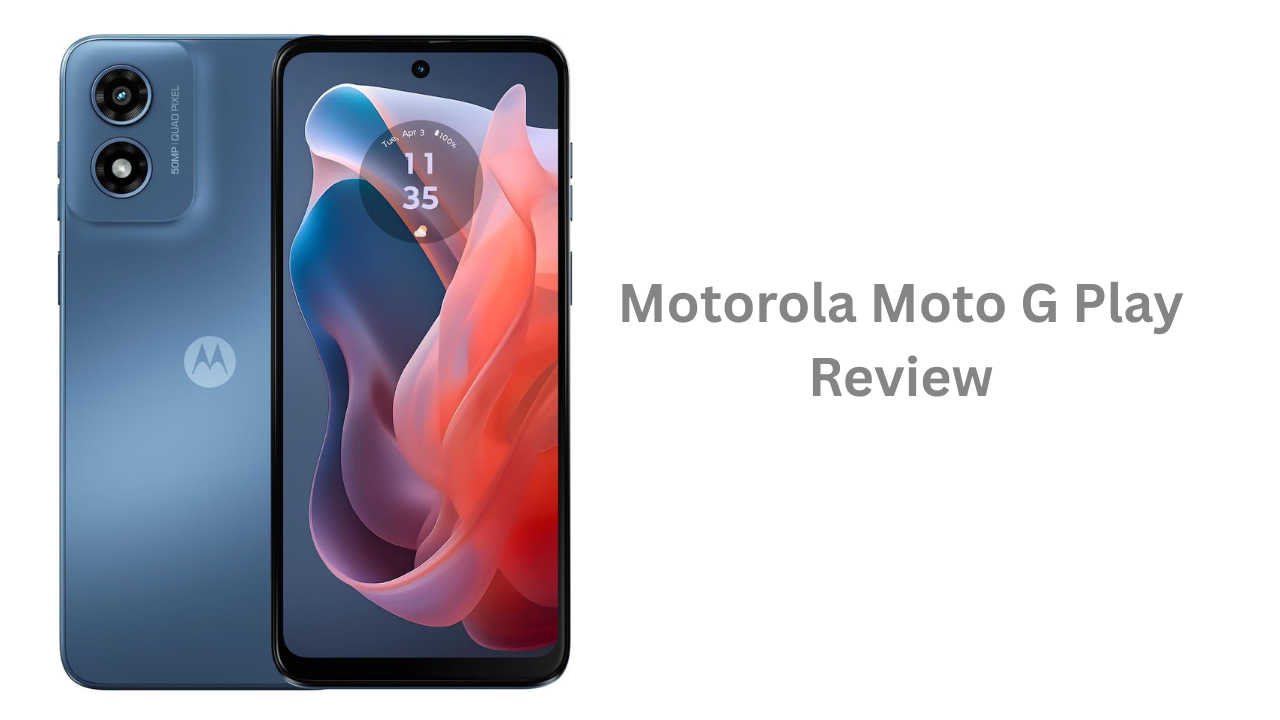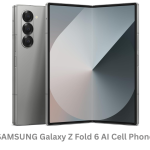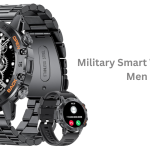The Motorola Moto G Play (2023) in Camera Sapphire aims to deliver a reliable smartphone experience at an exceptionally budget-friendly price. With a focus on long battery life, solid everyday performance, and a no-frills approach to features, this model addresses the needs of users who simply want their phone to work throughout the day without constant recharging. Below, we’ll delve into its design, display, performance, camera capabilities, battery life, software experience, connectivity options, and overall suitability—all without leaning on technical citations or source quotes.
Design & Build: Rugged Utility, Simple Aesthetics
From the moment you pick up the Moto G Play, you notice its utilitarian nature. Constructed from polycarbonate, the unibody frame feels sturdy and resistant to the kind of dings and scratches that often plague glass-backed phones. Its Camera Sapphire finish projects a glossy, deep-blue sheen that catches light attractively, though it easily shows fingerprints and smudges. The textured back panel helps mitigate this by providing a subtle grip, which is reassuring during everyday use—especially in one-handed scenarios.
At roughly 6.5 inches tall, the G Play is on the larger end of the spectrum, but its rounded corners and gently curved back keep it feeling surprisingly comfortable in the hand. Weighing in at around 200 grams, it carries a reassuring heft without feeling overly bulky. Its plastic frame and back belie the phone’s durability; a few casual drops onto carpeted floors and table edges produced no visible damage. While the design clearly prioritizes function over form, it still feels cohesive rather than cobbled together. Motorola has opted for straight-forward, rectangular camera housing on the rear, ensuring that the G Play’s appearance remains clean and intentional, even if not premium.
Display: Serviceable Size with Noticeable Limitations
Inside that durable shell lives a 6.5-inch TFT LCD panel running at a 720 × 1600 resolution. On paper, the 90 Hz refresh rate is a pleasant surprise at this price point, promising smoother scrolling and animations than standard 60 Hz panels. In practice, that higher refresh rate does add perceptible fluidity when swiping through apps or social media feeds, and it makes navigating menus slightly more responsive. However, the benefits of the faster refresh rate are somewhat hampered by the panel’s limited brightness and muted color reproduction.
Under bright outdoor conditions, the screen frequently hovers around mid-level brightness at best, which makes reading text or viewing photos in direct sunlight a challenge. During a midday walk with the phone in my hand, I found myself shading the top of the display with my palm just to discern incoming messages. Indoors or in shaded areas, the panel looks decent for basic tasks—browsing, streaming videos, and casual gaming—but it lacks the vibrancy and contrast found on higher-end IPS or OLED screens. Blacks can appear more like dark grays at off angles, and colors do not “pop” as much as one might hope.
Ultimately, the G Play’s display serves its purpose: it’s large, legible enough for most daily activities, and enriched by a smoother experience courtesy of 90 Hz. But if you’re someone who frequently uses your phone outdoors or expects rich, vivid visuals, you’ll likely find this screen falls short of more advanced panels available even on slightly pricier models.
Performance: Helio G37 Chipset Keeps Things Realistically Snappy
Under the hood resides a MediaTek Helio G37 processor paired with 3 GB of RAM and 32 GB of onboard storage (expandable via microSD). In day-to-day use—checking email, sending messages, streaming music, or scrolling through social feeds—the phone handles tasks adequately. Apps launch with a brief pause, and occasionally you’ll notice a slight hitch when switching between multiple apps. Heavy multitasking is not the G Play’s forte; if you keep more than three or four memory-hungry apps in the background, expect the system to reload some of them when you return.
Gaming performance aligns with the modest price point. Casual titles and older 2D games run without issue, but demanding 3D titles or anything graphics-intensive will push the handset toward its limits. One afternoon of playing a popular mobile battle royale game demonstrated noticeable frame drops during complex animations, though turning graphics settings down to “low” stabilized paddle-to-paddle combat. Still, for anyone prioritizing a fluid gaming experience, even at lower settings, the G Play lags behind more powerful mid-range alternatives. For users whose primary functions are messaging, navigation, occasional video calls, and light gaming, the Helio G37 is an acceptable compromise that keeps the cost low.
Camera System: Adequate in Daylight, Struggles After Sunset
Motorola has given the G Play a triple-camera setup: a 16 MP main sensor, a 2 MP macro lens, and a 2 MP depth sensor for basic portrait mode effects. In bright, well-lit environments, the main camera performs decently. Daytime street scenes, landscapes, and group photos appear reasonably detailed—with the caveat that dynamic range can be limited, so bright skies and shadowed areas sometimes prove challenging. Color balance generally veers toward neutral rather than overly saturated, which some will appreciate as more “true to life,” though it also lacks the punchy vibrancy you see in some competing devices.
Once lighting dips, however, limitations become glaring. Without a dedicated night mode to aggregate multiple exposures, shots taken in the evening or indoors tend to turn out grainy, muted, and soft. The macro lens, meant for close-up shots, requires you to keep your subject more than 5 cm away before it can lock focus—any closer and the image blurs. Portrait mode occasionally miscalculates edges, resulting in uneven background blur or odd haloes around hair. The 8 MP front camera is serviceable for video calls or casual selfies in strong light, but its low-light performance mirrors that of the main camera—grainy and lacking detail. In short, the G Play’s camera system will satisfy users who snapshot everyday moments in daylight but leaves much to be desired for low-light photography or those seeking a higher level of image fidelity.
Battery Life: Exceptional Endurance That Outshines Rivals
Where the Moto G Play (2023) truly distinguishes itself is in battery life. Its 5,000 mAh cell, combined with the energy-efficient Helio G37 chipset and the relatively modest demands of its display, routinely delivers more than a full day of heavy use. In mixed-use testing—comprising several hours of streaming video, a couple of GPS navigation sessions, continuous social media browsing, and intermittent phone calls—the device lasted approximately 36 hours before dipping below 10 percent.
Even during a full workday that included navigating through traffic, juggling phone calls, photographing a few meetings, and streaming music on the commute, the G Play returned home with around 40 percent battery remaining. In lighter usage scenarios—sporadic texting, occasional web browsing, and checking email—the phone can stretch to two days easily. For travelers, students, or anyone who dislikes tethering themselves to a charger, that kind of longevity is a game-changer.
The trade-off is that charging is rather slow. The G Play arrives with a 10 W adapter, and from zero to 100 percent takes nearly three hours. There’s no support for fast-charging technologies beyond the basic 10 W, nor is there wireless charging. However, given how infrequently you have to plug it in, most users likely won’t find the slow charge a major inconvenience—especially if you develop a habit of topping up overnight.
Software Experience: Near-Stock Android Keeps Things Clean
Motorola supplies the G Play with a near-stock version of Android 13, lightly skinned by its My UX interface. This means you get the simplicity and familiarity of Google’s own Android layout—app drawer, fresh iconography, straightforward settings—while still enjoying a handful of Motorola-specific gestures and tweaks. For instance, a quick double twist of the wrist launches the camera instantly, and a two-chop motion toggles the flashlight. These little touches feel genuinely useful, rather than tacked on for the sake of having “unique” features.
Bloatware is minimal. Aside from a few preinstalled Motorola utilities—like a data usage monitor and a device tuning app—most of the content on the phone is either Google’s stock apps (Maps, Photos, Drive, etc.) or optional downloads you can remove at will. This lean approach helps conserve the available 32 GB of storage (of which roughly 22 GB remains free out of the box) and ensures that the system feels nimbler over time.
One downside: Motorola’s update commitment for the G Play is modest. You can expect a single major OS upgrade (to Android 14) and around three years of security patches. In an era when many manufacturers promise two OS upgrades or more, this limited roadmap may concern users who wish to keep pace with new Android features beyond the near future. Still, the phone’s clean interface and minimal modifications foster a cohesive, ad-free experience that feels consistent day to day.
Connectivity & Extras: The Essentials, No Frills
The Moto G Play offers the core connectivity features you’d expect: dual-band Wi-Fi (802.11 ac), Bluetooth 5.1, GPS/GLONASS/Beidou for reliable location tracking, and LTE support on all major North American carriers. There’s a 3.5 mm headphone jack—a rarity at many price points these days—which pleased me when I dug out my older wired headphones for a podcast session. On the downside, there’s no NFC chip, so contactless payments via Google Pay or similar services are unavailable. If you rely on tap-to-pay, you’ll need to carry a physical credit card.
The phone’s side-mounted fingerprint sensor unlocks the device reliably in under half a second, and Face Unlock via the front camera provides an alternate biometric option, though it’s notably less secure and slower in low light. Its mono bottom-firing speaker is loud enough for conference calls or YouTube videos but lacks depth and bass. A single speaker means sound can easily muffle if your hand or the case partially covers the grill. Overall, connectivity is straightforward and dependable, focusing on the essentials rather than fancy extras.
Who Is the Moto G Play (2023) For?
The Moto G Play (2023) finds its sweet spot among users who value battery longevity and solid everyday functionality over flashy features or cutting-edge performance. If you need a dependable phone for texting, emailing, social media, streaming video, and light photography—without charging every night—this device fits the bill. Students on a budget, seniors who want a fuss-free smartphone, or professionals seeking a reliable second “backup” phone will appreciate its multi-day endurance and no-nonsense design.
Conversely, those who crave high-performance gaming, low-light camera breakthroughs, or 5G connectivity should look elsewhere. If you prefer richer displays (IPS or AMOLED), faster processors capable of intensive multitasking, or premium features like NFC payments and wireless charging, stepping up to a mid-range model—even one that costs just $50–$100 more—may be worth it.
Final Verdict: Unpretentious, Enduring, and Dependable
At its core, the Motorola Moto G Play (2023, Camera Sapphire) is a pragmatic smartphone designed to excel at the basics without pretense. Its 5,000 mAh battery consistently outperforms nearly every competitor in its price range, ensuring you can go two—or even three—days between charges under moderate use. The sturdy polycarbonate build, clean software experience, and ample screen real estate make daily tasks feel natural, even if the display and camera systems show their budget pedigree under scrutiny.
For those prioritizing reliability, battery life, and simple, uncluttered software, the G Play delivers impressive value. It won’t dazzle with spectacular photo quality or deliver the raw power of pricier handsets, but it proves that you don’t need to spend top dollar to own a phone that works hard and charges infrequently. If staying connected, productive, and entertained on a shoestring budget is your goal, the Moto G Play is an unapologetically straightforward solution that earns its place as a capable, enduring everyday companion.
mrsuggest.online is a participant in the Amazon Services LLC Associates Program, an affiliate advertising program designed to provide a means for sites to earn advertising fees by advertising and linking to Amazon.com and affiliated sites.
As an Amazon Associate, we earn from qualifying purchases. This means that some of the links on our website are affiliate links, and if you click on them and make a purchase, we may receive a small commission — at no additional cost to you.
We only recommend products that we genuinely believe will add value to our visitors. All reviews and opinions expressed on this website are our own.



